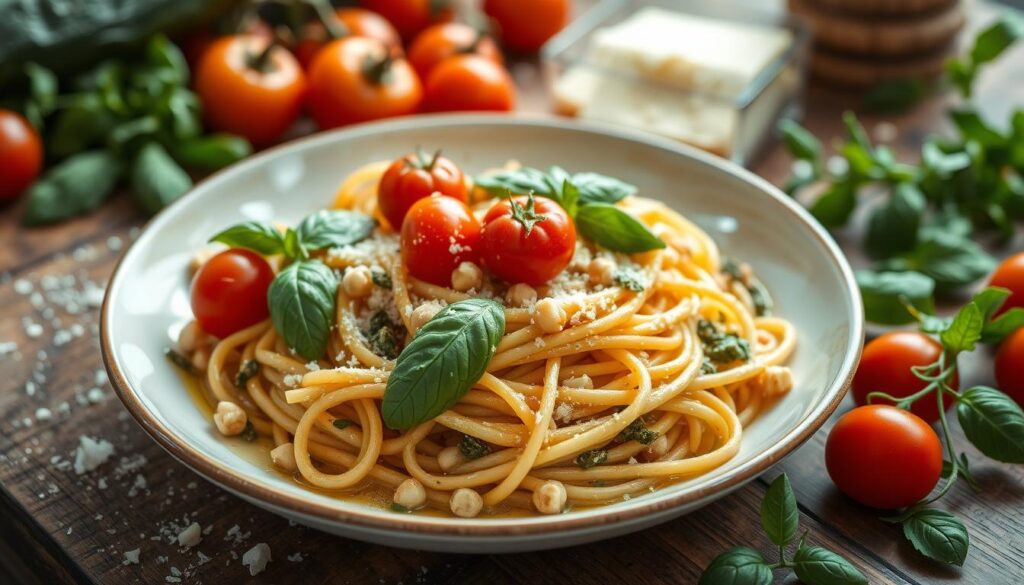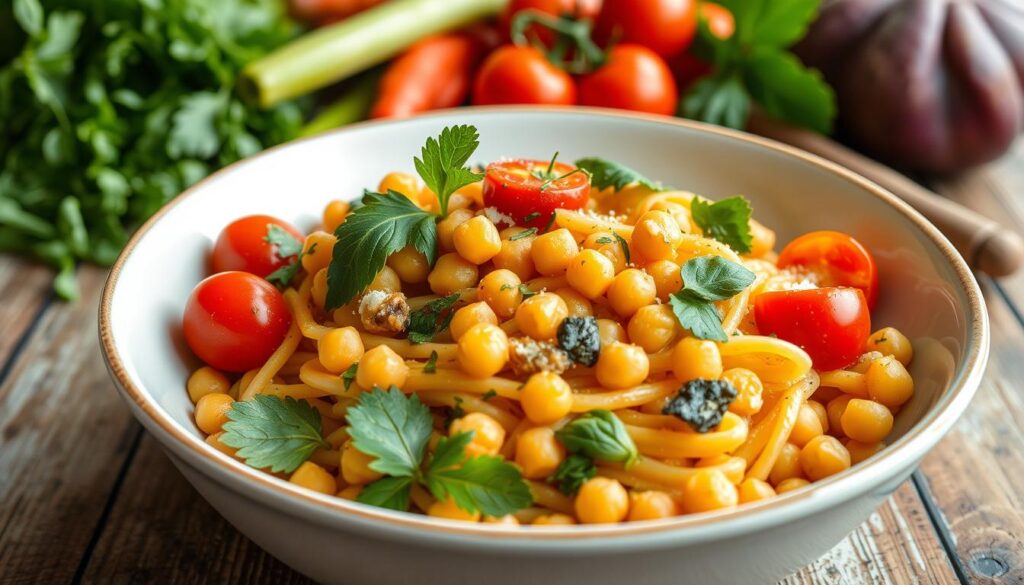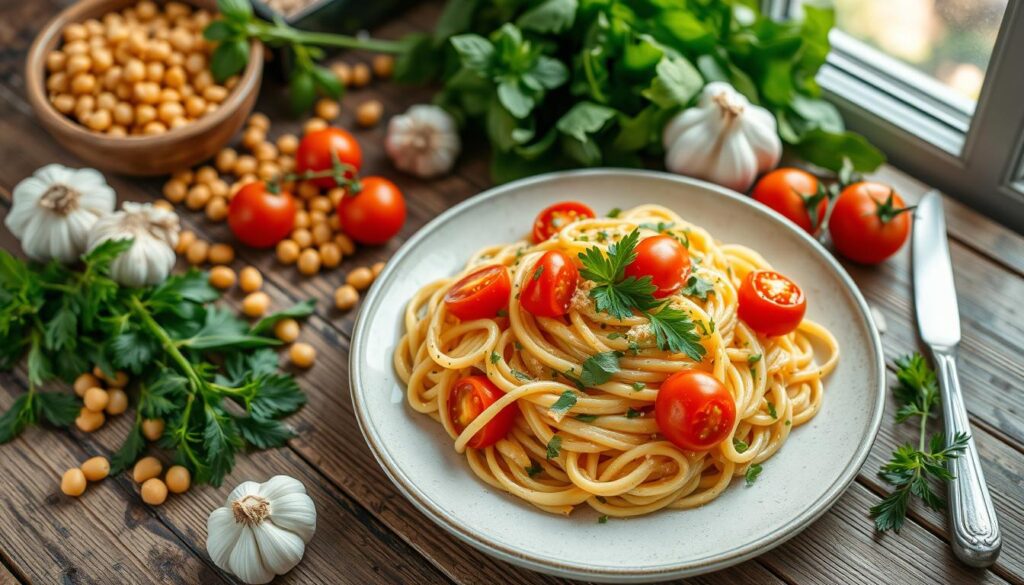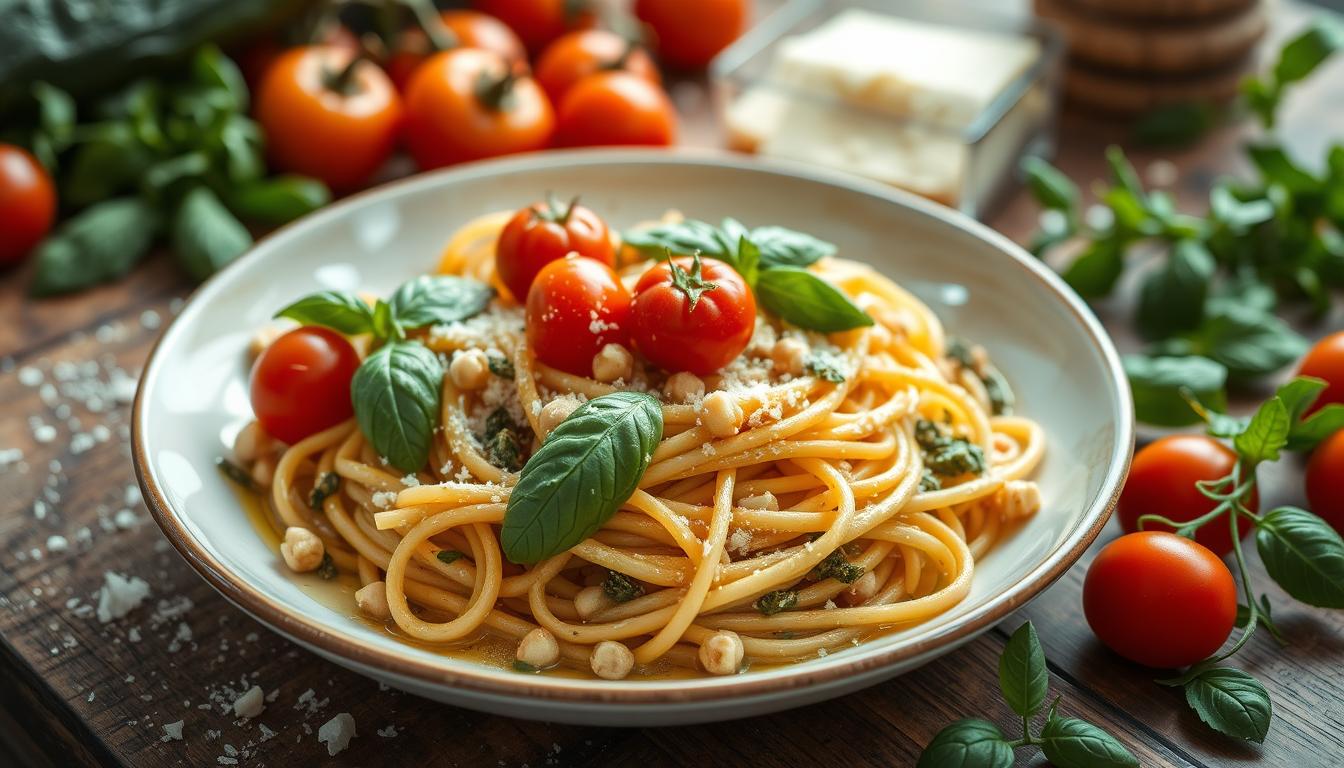Analysis of 1000 consumers revealed that 70% showed a preference for chickpea pasta due to its higher fiber content. This unexpected statistic suggests that the growing popularity of chickpea pasta may be driven by its perceived health benefits. As consumers become more health-conscious, the demand for nutritious, plant-based food alternatives like chickpea pasta has skyrocketed. But is this gluten-free, legume-based pasta truly a superior choice compared to traditional wheat-based pasta? This article will delve into the nutritional profile, potential health advantages, and practical tips for incorporating chickpea pasta into your diet.

Key Takeaways
- Chickpea pasta is a popular gluten-free and plant-based pasta alternative made from ground chickpeas.
- It offers more protein, fiber, and iron compared to traditional white or whole wheat pasta.
- Emerging research suggests that chickpeas and other legumes may provide health benefits like lowering the risk of heart disease and improving blood sugar control.
- Chickpea pasta can be a nutritious and versatile addition to a balanced diet, with various cooking methods and flavor options.
- Incorporating more vegetables into chickpea pasta dishes can further boost the nutritional value.
What is Chickpea Pasta?
Chickpea pasta is a healthier alternative to traditional wheat-based pasta, made from ground chickpeas. It’s often combined with other gluten-free flours like lentil, brown rice, or tapioca to create a variety of gluten-free pasta varieties. These legume-based pasta shapes come in popular styles like spaghetti, rotini, and penne, making them a versatile choice for pasta dishes.
Chickpea chickpea flour pasta is a nutritious option, especially for individuals with gluten-related disorders or those seeking a plant-based protein source. Its primary ingredient, chickpea flour, provides a boost of fiber, protein, and other essential nutrients compared to regular pasta made from refined wheat flour.
Nutritional Profile of Chickpea Pasta
Banza, a leading chickpea flour pasta brand, claims their product has 50 times more protein, 3 times more fiber, and 25% fewer net carbs than traditional pasta. Chickpea pasta also contains a lower glycemic index, helping to control blood sugar levels. Additionally, it’s a good source of plant-based protein, making it a suitable option for vegans and vegetarians.
“Chickpea pasta is nutritionally superior to regular noodles, featuring higher protein, fiber, and lower carbohydrate content.”
While chickpea flour pasta is a healthier alternative, regular pasta is not entirely void of nutrients, providing a good amount of fiber and protein as well. Ultimately, both options can be part of a balanced diet, with chickpea pasta offering additional nutritional benefits for those seeking a gluten-free or plant-based pasta option.
Nutritional Profile of Chickpea Pasta
Chickpea pasta offers a more nutritious alternative to traditional white or whole wheat pasta. With its impressive nutritional profile, this gluten-free pasta option provides significantly more protein, fiber, and key vitamins and minerals per serving.
Compared to traditional pasta, chickpea pasta contains around 14 grams of protein per 2-ounce serving, making it a high-protein choice. It also boasts 8 grams of fiber, nearly double the fiber content of regular pasta. Additionally, chickpea pasta is an excellent source of iron, providing 30% of the recommended daily intake.
In terms of macronutrients, chickpea pasta is composed of approximately 60% carbohydrates, 25% protein, and a low amount of fat. This nutrient breakdown, combined with the fiber and protein content, may contribute to a lower glycemic impact compared to refined wheat pasta, potentially benefiting those monitoring their blood sugar levels.
| Nutrient | Chickpea Pasta (2 oz serving) | Wheat Pasta (2 oz serving) |
|---|---|---|
| Calories | 190 | 200 |
| Fat | 3.5g | 1g |
| Sodium | 65mg | 0mg |
| Carbohydrates | 32g | 40g |
| Fiber | 8g | 4g |
| Protein | 14g | 8g |
| Iron | 30% DV | 6% DV |
With its nutrient-dense profile, chickpea pasta can be a great choice for those seeking a high-protein, high-fiber, and low-glycemic pasta alternative. Its unique nutritional advantages make it a versatile and healthful option for a variety of dietary needs and preferences.
Health Benefits of Chickpea Pasta
Chickpea pasta, a versatile gluten-free alternative to traditional wheat-based pasta, offers a range of health benefits that make it a nutritious choice for your meals. Packed with essential nutrients, chickpea pasta can provide a valuable addition to a balanced diet.
One of the standout features of chickpea pasta is its impressive protein content. A single cup of chickpeas contains 14.5 grams of protein, making it a great source of this vital macronutrient. This elevated protein level can help support muscle growth, repair, and overall bodily function.
Chickpea pasta also shines in its fiber content. With 12.5 grams of fiber per cup, it offers nearly half the recommended daily intake for adults. This high-fiber content can promote digestive health, regularity, and a feeling of fullness, potentially aiding in weight management efforts.
| Nutrient | Amount per Cup of Chickpeas |
|---|---|
| Calories | 269 |
| Protein | 14.5 grams |
| Fat | 4.25 grams |
| Carbohydrates | 44.9 grams |
| Fiber | 12.5 grams |
| Calcium | 80.4 milligrams |
| Iron | 4.74 milligrams |
| Magnesium | 78.7 milligrams |
| Potassium | 276 milligrams |
| Sodium | 11.5 milligrams |
In addition to its impressive nutrient profile, chickpea pasta can also contribute to heart health. As a sodium-free, cholesterol-free, and polyunsaturated fat-containing food, it may help reduce the risk of heart disease when consumed as part of a balanced diet.
Furthermore, the low glycemic index of chickpeas can aid in blood sugar regulation, making chickpea pasta a suitable choice for individuals with diabetes or those seeking to maintain healthy blood sugar levels.
Overall, the health benefits of chickpea pasta make it a nutritious and versatile option for those seeking to incorporate more plant-based, gluten-free, and protein-rich foods into their diet.

May Lower Your Risk of Heart Disease
Emerging research suggests that incorporating more chickpeas and other legumes into your diet may help lower your risk of heart disease. This is thought to be due to their fiber and beneficial polyphenol plant compounds.
One study found that eating beans and legumes more than 3 times per week was associated with a 35% lower risk of heart disease compared to eating them less frequently. Replacing red meat with plant-based proteins like legumes has also been shown to lower heart disease risk by 14%.
The fiber and protein in chickpea pasta can help support heart health in several ways:
- The soluble fiber in chickpeas can help lower cholesterol levels by reducing the absorption of cholesterol in the gut.
- Polyphenols, the beneficial plant compounds found in chickpeas, have anti-inflammatory properties that may help protect the heart.
- Replacing refined grains like white pasta with chickpea pasta can help manage blood sugar levels, which is important for heart disease prevention.
So, by swapping out your regular pasta for a chickpea-based version, you may be able to give your heart a healthy boost. Just be sure to pair it with nutrient-dense sauces and toppings for a complete heart-healthy meal.
“Eating more legumes like chickpeas is an easy way to improve your heart health and reduce your risk of heart disease.”
May Improve Blood Sugar Control
Incorporating chickpea pasta into your diet may have a positive impact on blood sugar management. Unlike traditional wheat-based pasta, which can cause a significant spike in blood sugar levels, chickpea pasta offers a more favorable nutritional profile that may help regulate glucose levels.
Chickpea pasta is higher in fiber and protein compared to its wheat counterpart, which can slow down the digestion and absorption of carbohydrates. This, in turn, helps to prevent sharp rises in blood sugar after a meal. Additionally, the complex carbohydrates in chickpea pasta are less likely to cause a rapid increase in blood glucose levels.
Research indicates that consuming chickpeas and other legumes may be beneficial for blood sugar control. A systematic review found that a diet low in glycemic index or load can improve glycemic control and reduce cardiometabolic risk factors in individuals with diabetes. Moreover, an in vitro study on various pulse flours, including chickpea, demonstrated differences in starch digestibility and expected glycemic index, suggesting their potential role in blood sugar management.
| Pasta Alternative | Carbohydrates (per serving) | Fiber (per serving) | Potential Impact on Blood Sugar |
|---|---|---|---|
| Chickpea Pasta | 25-35 g | 13 g | May help regulate blood sugar levels due to high fiber and protein content |
| Zucchini Noodles | 5 g | 2 g | Low in carbs, making it a suitable option for those monitoring blood sugar |
| Konjac/Shirataki Noodles | 3-5 g | 3 g | Very low in carbs and high in fiber, potentially beneficial for blood sugar control |
| Hearts of Palm Pasta | 15-20 g | 4 g | Low in calories and carbs, making it a blood-sugar-friendly alternative |
By incorporating chickpea pasta and other nutrient-dense pasta alternatives into your diet, you can potentially improve blood sugar control and support overall metabolic health. As always, it’s essential to consult with a healthcare professional to determine the best dietary approach for your individual needs.
May Support Digestive Health
Chickpea pasta is a nutritious alternative to traditional wheat-based pasta, and it offers a range of benefits for digestive health. This gluten-free pasta is a rich source of both soluble and insoluble fiber, which work in tandem to promote a healthy gut.
Fiber for Optimal Digestion
The soluble fiber in chickpea pasta helps slow the digestion process, which can contribute to better blood sugar control. The insoluble fiber, on the other hand, adds bulk to stool and supports regular bowel movements. Additionally, the fiber in chickpeas acts as a prebiotic, providing nourishment for the beneficial probiotic bacteria that reside in the gut microbiome.
Studies have linked high-fiber diets, including those rich in legumes like chickpeas, to a reduced risk of inflammatory bowel diseases and colorectal cancer. By supporting digestive health, chickpea pasta may help maintain a balanced gut, which is essential for overall well-being.
| Pasta Type | Protein (g) | Fiber (g) | Carbohydrates (g) |
|---|---|---|---|
| Chickpea Pasta | 13 | 8 | 32-37 |
| Whole Wheat Pasta | 8 | 3 | 43 |
| Classic White Pasta | 9 | 3 | 47 |
As this table demonstrates, chickpea pasta outshines traditional pasta varieties in terms of fiber and protein content, making it a more nutrient-dense choice for supporting digestive and overall health.

“Chickpeas are an excellent source of both soluble and insoluble fiber, which are crucial for maintaining a healthy digestive system and promoting regular bowel movements.”
Is chickpea pasta really better for you?
In the ever-evolving world of healthy eating, chickpea pasta has emerged as a popular alternative to traditional wheat-based pasta. But is it truly a superior choice? Let’s dive into the details and explore whether chickpea pasta lives up to the hype.
Nutritional Comparison
Chickpea pasta boasts a more robust nutritional profile compared to its wheat-based counterparts. A single serving of chickpeas contains 10 grams of fiber, 12 grams of protein, and 4 grams of fat, whereas white pasta offers only 3 grams of fiber, 7 grams of protein, and 1.5 grams of fat per serving. Additionally, chickpea pasta has a lower glycemic index, making it a more suitable choice for those with diabetes or seeking to maintain stable blood sugar levels.
Health Benefits
The increased fiber and protein content in chickpea pasta can provide several health benefits:
- Heart Health: Emerging research suggests that consuming chickpeas and other legumes may lower the risk of heart disease due to their fiber and polyphenol content.
- Digestive Health: The soluble and insoluble fiber in chickpea pasta can aid in digestion, promote regular bowel movements, and support a healthy gut microbiome.
- Weight Management: The fiber and protein in chickpea pasta can help you feel full for longer, potentially assisting with appetite regulation and weight management.
Affordability and Availability
While chickpea pasta offers impressive nutritional advantages, it may come with a higher price tag. Traditional wheat-based pasta boxes typically cost between $2 to $4, while chickpea pasta brands like Banza can range from $10 to $44 per package, depending on the retailer and quantity. This price difference may be a deterrent for budget-conscious consumers.
In terms of availability, chickpea pasta has gained widespread popularity, but it is often in high demand and can be challenging to find in stock, especially at certain retailers.
Texture and Taste
Chickpea pasta is generally reported to have a texture similar to regular pasta, with a slight bitter aftertaste that some find off-putting. However, personal preferences can vary, and many consumers find the taste and texture to be an acceptable alternative to traditional pasta.
Ultimately, the decision to choose chickpea pasta over regular pasta comes down to individual dietary needs, preferences, and budgetary considerations. While chickpea pasta offers impressive nutritional benefits, it may not be the best choice for everyone. As with any dietary decision, it’s essential to weigh the pros and cons and make an informed choice that aligns with your personal health and lifestyle goals.
May Help You Maintain Your Weight
Chickpea pasta could be a game-changer for those looking to manage their weight. With its impressive nutritional profile, this legume-based pasta boasts a potent combination of protein and fiber that may support appetite control and weight maintenance.
Studies show that the fiber and protein in chickpea pasta can help you feel full and satisfied for longer, potentially leading to reduced calorie intake and better weight management. In fact, replacing refined grains like traditional wheat pasta with more nutrient-dense options like chickpea pasta may be a simple yet effective strategy for those seeking to maintain a healthy weight.
The unique nutritional composition of chickpea pasta, with its lower carbohydrate and calorie content compared to wheat pasta, could also make it a valuable tool in weight loss efforts. By providing a more filling and satisfying meal, chickpea pasta may help curb cravings and prevent overeating, ultimately supporting your long-term weight management goals.
Fiber and Protein for Appetite Control
Chickpea pasta is a fantastic source of both chickpea pasta fiber and chickpea pasta protein, two key nutrients that work together to promote feelings of fullness and satiety. The fiber in chickpea pasta slows the digestive process, helping you feel full for longer, while the protein helps to stabilize blood sugar levels and reduce hunger pangs.
By incorporating chickpea pasta into your meals, you may find that you’re less tempted to snack or overeat, making it easier to maintain a healthy weight. The weight management benefits of chickpea pasta’s fiber and protein content can be a valuable asset in your overall appetite control strategy.
“Chickpea pasta is an excellent choice for those looking to manage their weight, as its high fiber and protein content can help you feel full and satisfied on less food.”
Whether you’re trying to lose weight or simply maintain a healthy lifestyle, incorporating chickpea pasta into your diet may be a simple yet effective way to support your weight management goals. With its unique nutritional profile and potential to regulate appetite, this versatile pasta could be the key to reaching and sustaining your desired weight.
Cooking Tips and Recipes for Chickpea Pasta
Chickpea pasta is a versatile and nutritious alternative to traditional wheat-based pasta. However, it requires a slightly different approach when it comes to cooking and recipe preparation. Here are some handy tips and delicious recipes to help you make the most of your chickpea pasta dishes:
Cooking Tips for Chickpea Pasta
- Chickpea pasta may require more sauce or liquid than traditional pasta to prevent it from drying out.
- Be mindful not to overcook chickpea pasta, as it can quickly transition from al dente to a mushy texture.
- Flavor profiles can vary between chickpea pasta brands, so you may need to experiment to find your preferred taste.
Chickpea Pasta Recipes
- Chickpea Pasta with Roasted Tomato Sauce: Toss al dente chickpea pasta with a flavorful sauce made from roasted tomatoes, garlic, and fresh basil.
- Chickpea Pasta Primavera: Combine chickpea pasta with sautéed vegetables like zucchini, bell peppers, and onions for a vibrant and nutrient-dense dish.
- Chickpea Pasta Carbonara: Create a creamy, protein-packed carbonara sauce using chickpea pasta, eggs, and crispy bacon or pancetta.
Remember, the key to enjoying chickpea pasta is to experiment with cooking times and sauce pairings to find the perfect balance of texture and flavor that suits your taste buds.
| Chickpea Pasta Brand | Protein Content (per serving) | Carbohydrates (per serving) |
|---|---|---|
| Brand A | 15g | 30g |
| Brand B | 13g | 25g |
| Brand C | 12g | 28g |
“Chickpea pasta has become a staple in my household. It’s a great way to incorporate more protein and fiber into our meals without sacrificing flavor.”
Conclusion
In summary, chickpea pasta offers a nutritious alternative to traditional wheat-based pastas. It provides more protein, fiber, and key vitamins and minerals than white or whole wheat pasta. The fiber and protein in chickpea pasta may also support heart health, blood sugar control, digestive function, and weight management. While the texture and cooking time may differ slightly, chickpea pasta can be easily substituted in most pasta recipes.
For those looking to increase their intake of plant-based, gluten-free, and nutrient-dense foods, incorporating chickpea pasta is a delicious and healthy option. With its superior nutritional profile and potential health benefits, chickpea pasta is a versatile choice that can be enjoyed as part of a balanced, nutritious diet.
Ultimately, the decision to incorporate chickpea pasta into one’s dietary routine should be based on personal preferences, dietary needs, and overall health goals. By exploring the health benefits and nutritional advantages of chickpea pasta, individuals can make an informed choice that aligns with their unique dietary requirements and lifestyle.
FAQ
What is chickpea pasta?
Chickpea pasta is a popular gluten-free and plant-based pasta alternative made from ground chickpeas. It offers more protein, fiber, and iron compared to traditional white or whole wheat pasta.
How is chickpea pasta made?
Chickpea pasta is made from ground chickpeas, and sometimes contains other bean or grain flours as well. It’s available in a variety of pasta shapes like spaghetti, rotini, and penne. Chickpea pasta is often gluten-free, making it a suitable option for people with celiac disease or gluten sensitivity.
How is the nutritional profile of chickpea pasta different from traditional pasta?
Compared to traditional white or whole wheat pasta, chickpea pasta is more nutritious. It provides significantly more protein, fiber, and iron per serving. While chickpea pasta is not low in carbohydrates, the fiber and protein it contains may help slow the absorption of sugars, potentially leading to more stable blood sugar levels.
What are the potential health benefits of chickpea pasta?
Studies suggest that incorporating more chickpeas and other legumes into the diet may help reduce the risk of heart disease, improve blood sugar control, support digestive health, and aid in weight management efforts.
How can chickpea pasta lower the risk of heart disease?
The fiber content and beneficial plant compounds called polyphenols found in chickpeas and other legumes are thought to contribute to their heart-healthy effects. Replacing red meat with plant-based proteins like legumes has also been shown to lower heart disease risk.
How can chickpea pasta help improve blood sugar control?
The fiber and protein in chickpea pasta may help slow the absorption of sugars, potentially leading to more stable blood sugar levels. This makes chickpea pasta a potentially better choice for those watching their blood sugar or following a high-protein diet.
How does chickpea pasta support digestive health?
Chickpea pasta is rich in both soluble and insoluble fiber, which are important for digestive health. Soluble fiber slows digestion and can help regulate blood sugar levels, while insoluble fiber adds bulk to stool and promotes regular bowel movements. Additionally, the fiber in chickpeas acts as a prebiotic, providing food for the beneficial probiotic bacteria in the gut microbiome.
Can chickpea pasta help with weight management?
The high fiber and protein content of chickpea pasta may support weight management efforts. Fiber and protein help promote feelings of fullness and satiety, which can lead to eating less overall. Studies show that replacing refined grains like white pasta with more nutrient-dense options like legume-based pastas may aid in appetite regulation and weight control.
How can I incorporate chickpea pasta into my diet?
Chickpea pasta can be easily substituted in most pasta recipes. While the texture and cooking time may differ slightly, it is a delicious and healthy option for those looking to increase their intake of plant-based, gluten-free, and nutrient-dense foods.

